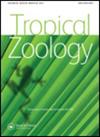马达加斯加特有果蝠出现和返回洞穴的时间,以及夜间活动的持续时间
IF 0.7
4区 生物学
Q4 ZOOLOGY
引用次数: 1
摘要
蝙蝠在黄昏后从白天的栖息地出来,不同的因素会影响它们离开、返回的时间和夜间活动的持续时间。本研究提供了马达加斯加特有果蝠Rousettus Madagascar的出现和返回时间的信息,这些果蝠出现和返回的时间位于马达加斯加北部ankarana的rsamserve spciale d 'Ankarana的一个洞穴。在栖息地和洞穴出口之间的狭窄通道中捕获个体,并记录每个个体的捕获时间。分析了不同性别、年龄、体质的差异,以及季节、日出日落时间的影响。在旱季,个体在1913小时开始出现,一般在0505小时返回洞穴;旱季出穴时间以雌成虫(0952 h)居多,其次为雄亚成虫(0937 h)、雌亚成虫(0931 h)和雄成虫(0910 h)。在雨季,个体于1926时离开,于0351时返回;与旱季一样,成年雌性在洞穴外停留的时间(0833小时)比亚成年雌性(0800小时)和成年雄性(0752小时)要长。出现的时间根据年龄和性别等级而不同,黎明前返回的时间与之前的夜间活动有关。回归时间受季节、年龄、性别等因素的影响。这些信息有助于量化蝙蝠生态的变化,特别是对于分布有限的特有物种或在生态系统服务中发挥重要作用的物种。本文章由计算机程序翻译,如有差异,请以英文原文为准。
Timing of emergence and cave return, and duration of nocturnal activity in an endemic Malagasy fruit bat
Bats emerge from their day roost after dusk and different factors can affect the timing of departure, return, and duration of nocturnal activities. This study provides information on the time of emergence and return of an endemic Malagasy fruit bat, Rousettus madagascariensis, in a cave located in the Réserve Spéciale d’Ankarana, northern Madagascar. Individuals were captured in a narrow passage between the roost and cave exit and capture time for each individual was noted. Variation according to sex, age, and body condition, as well as the influence of season, and the sunset and sunrise time were analyzed. During the dry season, individuals started to emerge at 1913 hours and returned to the cave generally by 0505 hours; the duration of time outside the cave during the dry season was higher in adult females (0952 hours) followed by subadult males (0937 hours), sub-adult females (0931 hours), and adult males (0910 hours). During the wet season, individuals exited at 1926 hours and returned at 0351 hours; as in the dry season, adult females spent more time outside the cave (0833 hours), than sub-adult females (0800 hours), and adult males (0752 hours). The period of emergence varied according to the age and sex classes, and time of predawn return associated with the previous nocturnal activity. The period of return was influenced by season, and age and sex classes. Such information is useful to quantify shifts in bat ecology, especially for endemic species with limited distribution or those playing an important role in ecosystem services.
求助全文
通过发布文献求助,成功后即可免费获取论文全文。
去求助
来源期刊

Tropical Zoology
生物-动物学
CiteScore
2.50
自引率
0.00%
发文量
1
审稿时长
>12 weeks
期刊介绍:
Tropical Zoology is an international zoological journal publishing original papers in the field of systematics, biogeography, phylogeny, ecology and conservation of all terrestrial and aquatic animal Phyla from tropical and subtropical areas.
Only papers with new information, high quality and broad interest are considered. Single species description and checklists are not normally accepted. Review papers are welcome. The journal is owned by the Istituto di Ricerca sugli Ecosistemi Terrestri of the Consiglio Nazionale delle Ricerche, Florence, Italy (CNR-IRET) who performs research into the structure and functioning of aquatic and terrestrial ecosystems, focusing in particular on anthropogenic pressure and global change. The knowledge amassed forms the scientific basis for identifying the most appropriate protective and corrective interventions, and provides support for the bodies entrusted with formulating policies for environmental protection and recovery.
 求助内容:
求助内容: 应助结果提醒方式:
应助结果提醒方式:


